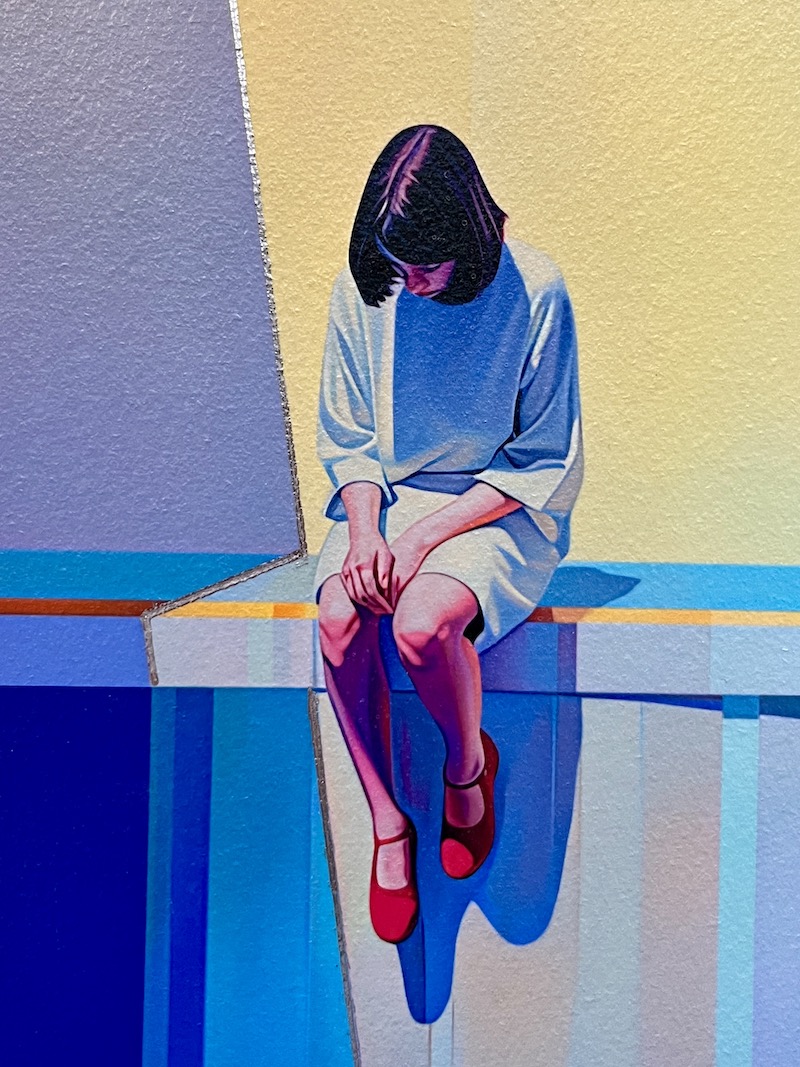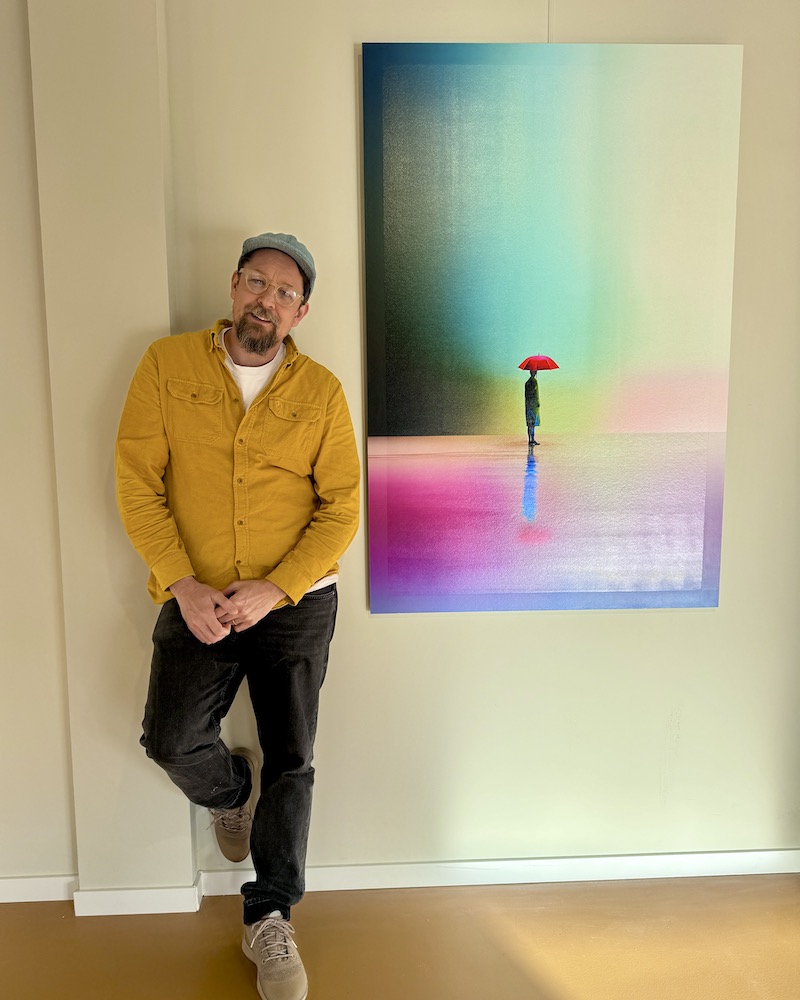Artist Interviews 2024
Kalle Hellźen 
By Julia Siedenburg

The art of Swedish artist and film director Kalle Hellźen not only takes you on an emotional and mentally stimulating journey, but it also never truly lets you go. I find myself thinking back a lot and continuously daydreaming about his artwork.
His pieces are so easy to connect with as they showcase the good and the bad sides of simply being a human being. The happy days, as well as the sad. The overwhelming need to feel the presence of someone, anyone, as well as the feeling of just being at peace in solitude.
Especially his work featuring women with black short hair truly touched me and in a way haunts me.
Growing up around Scandinavian folklore and music and (fun fact) having a specific kind of color blindness make this artist the unique talent that he is today.
I am so grateful he was able to share his thoughts and inspirations with me, and so with you, dear reader. So please enjoy diving in into the world of Kalle Hellźen:

In your opinion, what does art provide society?
Art, to me, acts like a universal glue that somehow feels intensely personal to each of us, yet it's this shared experience that really brings us together. It’s a window into understanding not just ourselves but each other. It has this incredible power to show us that we're not so different at the core despite our differences in habits and beliefs. The moments when art resonates with us, it's a reminder of our shared humanity, fostering a sense of community and empathy that's hard to replicate through any other medium.

Can you tell us what inspired you to focus on creating imagery that displays “Melancholy dipped in Sunshine”, as you put it so well on your website?
"Melancholy dipped in Sunshine" captures the essence of human experience for me—the blend of joy and sorrow, brightness and darkness, that coexists in our lives. It reflects the constant negotiation between these opposing forces within us. This theme is deeply rooted in personal experiences as well as the broader, universal search for meaning. It’s about embracing the complexity of our natures, finding beauty in imperfection, and recognizing the flickers of hope and renewal even in our darkest moments.

For me, your art shows a mysterious, beautifully colorful, yet lonely world where people exist in a state of helplessness and grief. Do you as the artist see creating art as a tool to calm your thoughts and shut yourself off from the world or does it help you to be active and keep your creativity flowing?
Creating art is a bit of both to me—it's my way of being present, a meditation of sorts. But, it’s not a complete escape nor a complete engagement with the external world but a unique blend of both. It's my way of processing reality, through my own lens, making sense of my thoughts and the world around me. It's not about shutting the world out but rather exploring my slice of it and my place within it.

During your work process, you create a mixed-media image; adding a special digital layer to your oils and acrylics is what makes your work so unique. What motivated you to combine traditional paintings with generative art forms?
My background as a creative and film director in commercial arts instilled a curiosity for exploring new approaches and technology. So, blending traditional mediums with digital tools has always been my natural way to do anything. Also, I'm allergic to best practices, and made-up rules, I would never let them limit me or my creative expression. Instead, I exist at the intersection of the foundational and the out-there.
Using digital tools, especially generative AI, allows me to enhance the depth and reach of my exploration. A note though, Bjork famously said, "It's the human who put the soul into the machine." You have to make sure that it's your soul you put in there. It's never OK to steal other people's work, AI or not.

You mention Hockney, Munch, and Hopper as artists whose art focused on loneliness and isolation has inspired your work. Who was one of the first artists that caught your eye?
Bauhaus, graphic novels, commercial poster art, Scandinavian folklore, and the melancholic harmonies of traditional Swedish folk music, mixed with many Chicano and Latinx influences from our time in Los Angeles, all play a significant role in my work. I think this eclectic mix has shaped me and my perspective rather than the influence of a single artist.

In your more recent works, you continuously showcase the same black-haired woman; who is she? Are any of your subjects connected to you in real life or do they all happen to be figments of your imagination?
She represents a blend of muse and metaphor, embodying various facets of the human condition. She appeared in a piece titled "Bird," symbolizing a pivotal moment of anticipation. While her physicality and posture come from an oil painting I did of my wife on a bridge in Stockholm, her essence resonates more broadly, capturing the universal vulnerability of those in-between moments that define us. She is both a personal reflection and an every-person, embodying the shared experiences that connect us all.

Please tell us a bit about your childhood and upbringing. How did you find your way to art while growing up with color blindness?
Growing up in Sweden in a creative household, I was surrounded by design and art and discussions about it, not just from an aesthetic POV but also from production and logistics. We moved a lot, my parents divorced when I was at an early age and my strong dialect didn't help me make new friends as we moved up to a Stockholm suburb from the south of Sweden. I felt somewhat alienated, and even though I didn't know it at the time, my general anxiety disorder and hyperfocus probably didn't help either. My color blindness was diagnosed in a routine screening when I was around seven or eight, adding another layer to feeling different. So it was yet another proof I was not fitting in.
For a long time, I was terrified of color, because I was afraid of making mistakes and standing out even more than I already did. But, over time, it became an important part of my approach to creativity, a unique challenge rather than a limitation. I have deutan colorblindness which enhances reds and diminishes greens so I navigate that with science and method. I approach it with great interest and curiosity now, almost spending more time on the palette than I do on the application of it. I started painting because I like to do things that are hard for me. So, when I figured I needed another way to express my creativity than through commercial art, I couldn't think of anything harder than oil painting, and I haven't looked back since.

Besides your amazing neon-lit paintings, you also create sculptures that are a big contrast as they are, except for a few color-splashed objects, mostly mute-colored. How different is the process when creating a sculpture versus a painting?
Expanding from two-dimensional artworks to 3D-printed sculptures is just a natural evolution of my practice, extending the narrative and presence of my characters into our physical space. These artworks demand a different awareness, inhabiting the same world as the viewer, which adds a unique depth to their story. Starting with more muted colors allowed these figures to assert their presence subtly, though we’re now introducing a more vibrant palette. It’s a fascinating process that allows me to explore the same themes in a new dimension.

Your subjects as well as your artistic style changed over the past few years. Would you say you’re moving to different countries and your surroundings had something to do with that?
Yes, but the decision to pursue art full-time gave me the space and capacity to dive deeper into it. I evolved from introspective exploration on borrowed time to a much more effective, productive, and expansive process and approach. This, along with a more comprehensive toolkit and just becoming better at the craft side of it, has allowed me to develop very quickly.

What artistic adventures do you have planned soon?
I am always experimenting with different substrates and the chemistry and impact of different pigments, mediums, and application techniques, pushing my work into new, sometimes messy, but always exciting territories. Regardless of the technique I use as an artist, I intend to evoke maximum emotional impact with my work.
|
|

